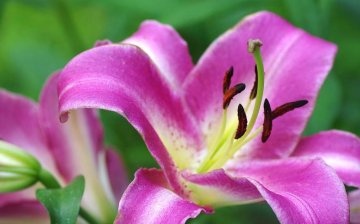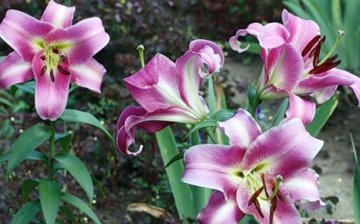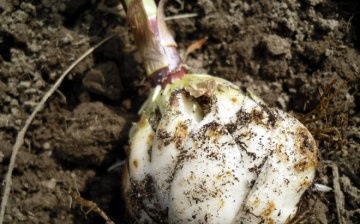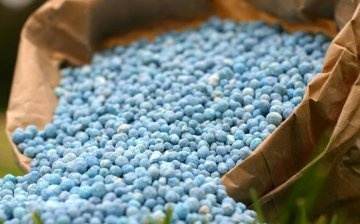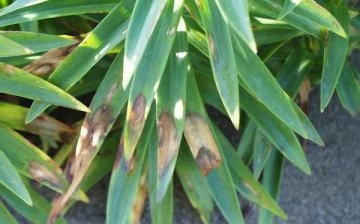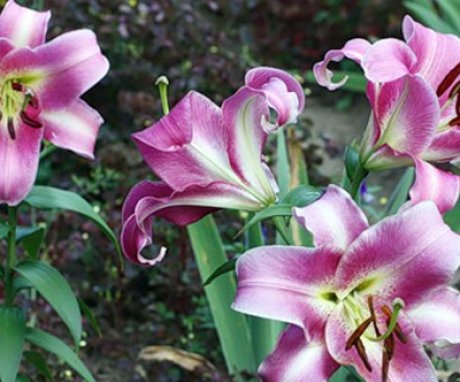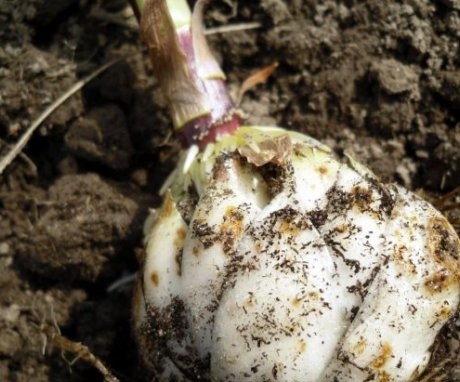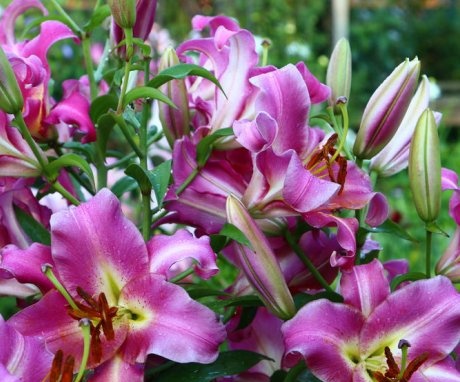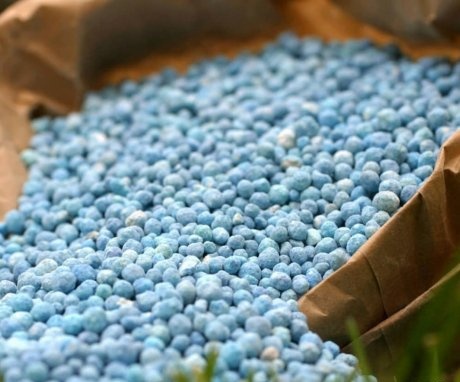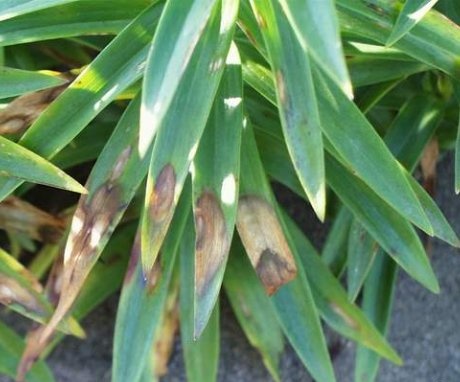Lily Purple Lady in the garden - from planting to leaving
Lily variety Purple Lady, which means "Purple Lady", refers to interspecific OT-hybrids.
Content:
- Description of the variety
- Reproduction of lily Purpl Lady
- Growing features
- Correct feeding of lilies
- Diseases and pests
Description of the variety
This variety combines all the advantages of Orientals (Oriental) and Trumpet Lilies:
- The stem is thin but strong. Its height reaches one and a half meters. It can be achieved that it becomes higher, but this will negatively affect wintering and subsequent flowering. The stem holds up to two dozen buds, which bloom gradually, starting from the lower ones.
- Flowers are large, cupped, up to 25 cm in diameter.
- The petals are wide, slightly corrugated, with a glossy effect.
- The color is pink, in the center there is a lighter stripe, which acquires a yellowish tint to the base. The stamens are purple. The tips of the petals are bent outward, the flower itself is directed upward. Blooms from July to August.
Advertisers refer to the Purple Lady's lily as the tree lily. In many ways, this is a publicity stunt and an exaggeration. The flower is really beautiful, striking in size and number of buds, their beauty and aroma. But you cannot call it a tree, because under normal conditions it does not differ much from other varieties of Orientals and Orientals.
Reproduction of lily Purpl Lady
The Purpl Lady lily is propagated by bulbs or scales from them. When choosing bulbs for planting, they carefully examine them. Reject those on the surface of which there are spots, mechanical damage, traces of rot. Pay attention to the shape and color of the bulb. Its scales should be adjacent to each other. The color must be the same for all parts and sides of the bulb.
Wash the lilies under running water for at least 20 minutes. Disinfect in a solution of potassium permanganate, foundation. To prevent damage by pests, they are treated with insecticides. Purchased lilies are stored in a cool place until planting. So that they do not dry out, they are placed in wet sand or moss.
In spring, the bulbs are planted in late April or early May. If they start to germinate too early, they are planted lily in a pot and set in a warm room. When the soil dries up, they are transplanted into open ground. Delayed planting threatens that young shoots will break during transplantation. In the fall, the bulbs are planted in late September or early October.
Landing features:
- A plot is prepared by applying fertilizers and digging to a depth of 40 cm.If necessary, drainage is laid under the plant. For this, ditches are dug so that they are inclined. Broken brick, gravel, expanded clay are laid at the bottom.
- Sprinkle with a layer of sand 5 cm high. Cover with soil on top. If the groundwater comes too close, high ridges are formed on top of the drainage.
- Large bulbs are planted 25 cm, small ones to a depth equal to three diameters. Before immersion in the soil, they are not removed from the wet sand or covered to protect them from the sun. Existing roots are carefully straightened so as not to break off.
- Mark the place where the bulbs were planted so as not to lose them. Seedlings can be covered with cut bottles to protect them from the sun's rays.
After digging, the daughter bulbs are carefully separated from the mother plant and planted for growing on the ridges.The planting depth is 10 cm, the distance between the bulbs is 15 cm. The plot is covered with humus for the winter. A full-fledged bulb will form in 2-3 years.
Growing features
Lily Purpl Lady grows well on loose fertile soils. It is better to grow it on slightly acidic soils. If the groundwater is close to the surface of the earth or rainwater stagnates on it, drainage is imperative. It will not interfere with loose and dry soils. After all, the climate is constantly changing, flood rains can occur where they usually do not happen.
If the soil on the site is heavy, sand is added. It will make the soil moisture-permeable, improve air access to the roots of the plant. The lily is planted so that in the summer, the lower part of the stems is in light partial shade. The stems of the Purple Lady lily are tall and the flowers are heavy, so the wind can break them off. The plant must be tied to a support. Withered flowers are removed so that they do not spoil the appearance of the bush.
Water the lily at the root, without falling on the leaves. It is necessary to bring water to the area where the lily grows only when necessary. Stagnation of moisture is destructive for her. If this nevertheless happened and the lily leaves began to turn yellow too early, dig up the lily, examine it. The dark areas affected by rot are removed. The bulb is disinfected in a manganese solution, treated with foundation. If the bulb is severely rotted, try to find whole scales. They are disinfected, planted in moist calcined sand. Maintain high humidity. When roots appear on them, they are planted in a greenhouse for growing. Any lilies can be propagated in this way.
To protect the bulb from drying out will help soil mulching straw, sawdust or a thick layer of cut grass.
Lily Purpl Lady, like all OT hybrids, is not very afraid of frost. But everything is enough to leave her for the winter without shelter. At the end of autumn, the upper part is cut off. They burn it to destroy the gathered pests and infection. Cover from above with dry foliage, spruce branches, humus.
In one place, the Purpl Lady lily can grow for 5 years. Babies are forming too slowly to be transplanted every year. Therefore, you need to wait until they reach at least 1 cm in diameter. The bulbs are dug out one and a half months after flowering, in early September, together with the ground. Garden forks are used, which are more difficult to damage the root system of the bulb.
Correct feeding of lilies
In order for the stems of the Purple Lady lily to grow as high as possible, and the flowers to be large, the plant needs to be fed regularly. In the spring, compost is introduced, during the growing season, it is watered with infusion of chicken manure diluted with water.
Mineral fertilizers make 100 g per square meter 3 times per season:
- In early spring, spreading fertilizer over the snow.
- After the formation of two or three sheets.
- Every 2 weeks until buds appear.
- During budding.
- After flowering.
This is necessary for the growth of the bulbs. Alternate application organic and mineral fertilizers. Do not apply fresh or unripe manure under the lilies. It contains pathogens that can spread to lilies.
Preparations containing nitrogen are applied no more than 7 kg / m2. Exceeding the norm can lead to "fattening". The stem will grow vigorously and the bulb will lag behind. It will endure the winter frosts worse, and next year the number of flowers will be insignificant. Disease resistance decreases.
Diseases and pests
OT hybrids are less affected by the main diseases of lilies than others. But they still suffer from fungal and viral diseases.
Fungal:
- Botrytis (gray rot) appears as brown spots on the leaves.
- Fusarium infects the bulb. May be manifested by yellowing of the leaves.
- Rhizoctonia infection affects the bulbs and roots.
- Blue rot appears during storage.
- Bacterial rot is a disease in which the leaves first rot, then the peduncles wither and rot.
- Root rot does not affect the bulb, but the roots of the plant.
- Rust.
For treatment and prevention, bulbs and plants are treated fungicides... Do not overmoisten the soil.
Viral diseases:
- Tobacco and cucumber mosaics.
- Variegatedness.
- Rosette (a complex of viral diseases).
Diseases lead to a change in the color, shape of the petals. Plants are not subject to treatment, they are destroyed.
More information can be found in the video:
The main pests of bulbs are vole mice. In winter, they can completely destroy the lilies. To prevent this, it is advised to install metal mesh protection when planting. In spring and summer, plants damage the lily beetle and lily fly larvae. You can destroy them by collecting them manually or by treating them with "Thunder", "Mukhoed" insecticides.
Lily Purple Lady is often planted separately from other large flowers. She herself can overshadow the neighboring plants with her beauty. Good neighbors for the Purple Lady lily will be daylilies, hosts, bells. They will protect the soil above the bulb from overheating and will replace the lilies after flowering. Purpl Lady lily petals in alcohol retain the aroma of the plant well. They are used to flavor bed linen. Purple Lady Lilies are used for forcing to get flowering on time. The duration of the forcing period is 110-120 days.



